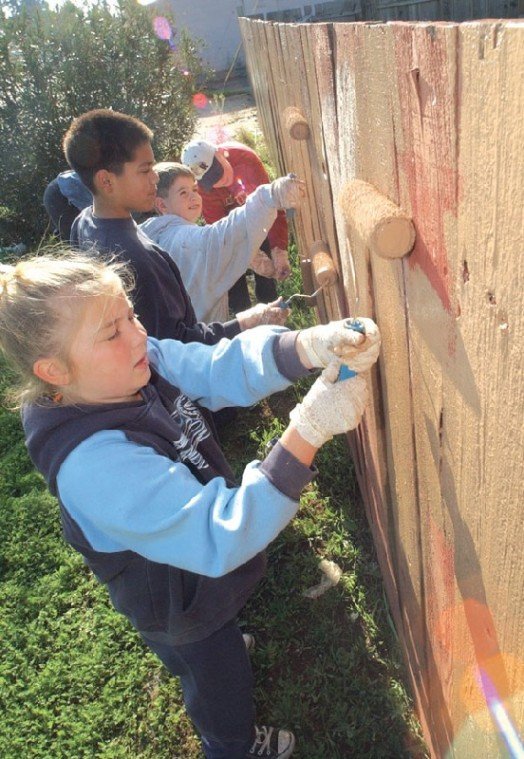Gilroy
– Taggers tempted to deface a Church Street fence will have to
go through 11-year-old Andrew Lanier first.
The St. Mary School sixth-grader adopted the fence across the
street from his campus as part of the Gilroy Police Department’s
Wipe Out Watch volunteer program to eradicate graffiti.
By Lori Stuenkel
Gilroy – Taggers tempted to deface a Church Street fence will have to go through 11-year-old Andrew Lanier first.
The St. Mary School sixth-grader adopted the fence across the street from his campus as part of the Gilroy Police Department’s Wipe Out Watch volunteer program to eradicate graffiti.
“I saw a lot of graffiti on the fence at recess and lunch,” Lanier said. “It was just ugly. I thought, if we don’t clean it up, then people are just going to keep doing it.”
Lanier’s mother Jennifer contacted GPD’s Neighborhood Resource Unit, which oversees graffiti abatement and the Wipe Out Watch. Angela Locke-Paddon, who responds to calls to the Graffiti Hotline during the week, supplied Lanier with paint and rollers to keep the fence graffiti-free.
“I thought maybe we could get a couple friends to help,” Lanier said. “It’s to make the community look better, so they were glad to help.”
Lanier and friends Sean Menroe, 12, Julio Aragon, 11, and sister Mckenzie, 9 – all St. Mary students – painted over the fence last week, with the owner’s permission. Now, they’ll do touch-ups every couple weeks, or as they spot any graffiti.
“That’s what’s nice about it – when they see it, they’ll go out and they know that’s part of their job now, to eradicate graffiti as they see it,” said Gail Tamez, graffiti staff coordinator for the GPD. “It was such a blessing, because it was like we were just discussing the fence.
“That’s something they can be proud of, because they can see it.”
Lanier sees it as a win-win situation because the city gets a more attractive fence and he and his schoolmates get bonus points. During the school’s annual awards ceremony, special recognition goes to anyone who completes at least 25 hours of community service. Lanier also will write a report on his volunteer service for a class project.
Stamping out graffiti is a seven-day-a-week job for the police department, and one that depends on the eyes and labor of volunteers like Lanier and his friends.
“The way our town is developing, growing, they find new areas to tag,” Tamez said. “There’s a lot – it’s every day.”
Locke-Paddon is responsible for graffiti eradication on weekdays, and another officer covers weekends. They respond to calls to the hotline the same day they’re made.
However, about 90 percent of the graffiti is spotted out on the streets. Community Service Officers either remove the vandalism themselves, enlist a contractor who works with the city, or alert the property owner.
In May and June, the GPD eradicated graffiti at 205 sites. In April, tagging was removed from 204 sites. Graffiti sometimes becomes more prevalent this time of year, Tamez said, and last January, 236 graffiti sites were eliminated.
Wipe Out Watch volunteers, who began working informally in the early 90’s, are bringing down graffiti’s cost to the city, Tamez said.
Graffiti cost the city $8,550 in 2003, down from $17,300 in 2000. In the past four years, police have received fewer graffiti-related calls and documented less graffiti square footage, but officers themselves have located more graffiti sites.
Tamez holds meetings for Wipe Out Watch volunteers that draw more than 15 people each month. Other volunteers, like Lanier, adopt and maintain one specific area, and some property owners are supplied with paint and rollers if they have a problem fence or wall. Local retailers, including Lowe’s, Home Depot and Orchard Supply, provide the department with recycled brown, gray and beige paint.
Murals painted in East Gilroy in the past couple years are also helping keep what were graffiti-prone areas easier on the eyes. A mural was painted behind the Pacheco Pass Motel on Old Gilroy Street in July 2003, and earlier this month, two murals for neighborhood children were painted on Rogers Lane, Tamez said.
Not only is graffiti an eyesore for city residents, when it is left visible, it gives credit to the taggers who put it there.
Mayor Al Pinheiro recently reminded fellow City Council members to be aware of eyesores, like graffiti, and his message echoed what the GPD’s graffiti abatement officials try to tell all residents.
“It’s simple to call it in,” Pinheiro said during a council retreat with the police and fire departments. “Don’t assume someone else will. It’s our city and our city looks like it does because of all the work we put into it.”
Not only is it unlawful to place graffiti (according to the state penal code), but it is illegal to allow it to remain on your Gilroy property for more than 48 hours. It’s illegal for anyone to possess any graffiti implement (spray paint, felt-tip marker, etc.) in a public park or recreation facility, and it’s illegal for anyone under 18 years old to possess any graffiti implement on private property without the property owner’s permission. It’s also illegal to sell a felt-tip marker or paint stick to anyone under 18 without parental permission, and businesses can’t store graffiti implements within public view or access. CSOs periodically monitor businesses for compliance.
Tagging is considered misdemeanor vandalism, and the punishment of fines and/or jail time depends on whether the act is committed by a juvenile or an adult.
To report graffiti, call the 24-hour Graffiti Hotline at 846-0395.













